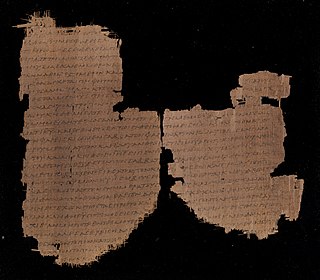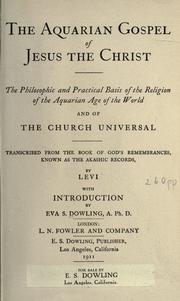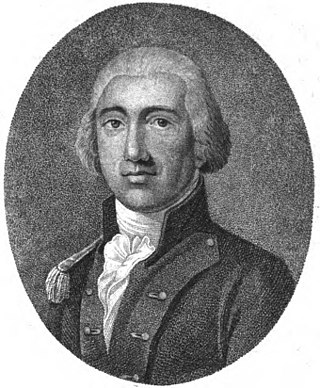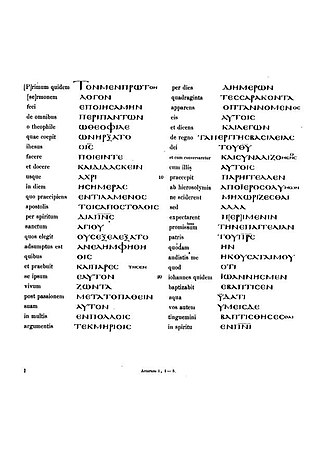
The Acts of the Apostles is the fifth book of the New Testament; it tells of the founding of the Christian Church and the spread of its message to the Roman Empire.

Barnabas, born Joseph (Ἰωσήφ) or Joses (Ἰωσής), was according to tradition an early Christian, one of the prominent Christian disciples in Jerusalem. According to Acts 4:36, Barnabas was a Cypriot Jew. Named an apostle in Acts 14:14, he and Paul the Apostle undertook missionary journeys together and defended Gentile converts against the Judaizers. They traveled together making more converts, and participated in the Council of Jerusalem. Barnabas and Paul successfully evangelized among the "God-fearing" Gentiles who attended synagogues in various Hellenized cities of Anatolia.

The Gospel of Barnabas is a non-canonical, pseudepigraphical gospel written in the Late Middle Ages and attributed to the early Christian disciple Barnabas, who is one of the apostles of Jesus. It is about the same length as the four canonical gospels combined and largely harmonises stories in the canonical gospels with Islamic elements such as the denial of Jesus' crucifixion. The gospel presents a detailed account of the life of Jesus. It begins with the nativity of Jesus, which includes the annunciation by the archangel Gabriel to Mary which precedes Jesus' birth. The gospel follows his ministry, ending with the message of Jesus to spread his teachings around the world. Judas Iscariot replaced Jesus at the crucifixion.

The Gospel of Luke tells of the origins, birth, ministry, death, resurrection, and ascension of Jesus Christ. Together with the Acts of the Apostles, it makes up a two-volume work which scholars call Luke–Acts, accounting for 27.5% of the New Testament. The combined work divides the history of first-century Christianity into three stages, with the gospel making up the first two of these – the life of Jesus the Messiah from his birth to the beginning of his mission in the meeting with John the Baptist, followed by his ministry with events such as the Sermon on the Plain and its Beatitudes, and his Passion, death, and resurrection.
The New Testament (NT) is the second division of the Christian biblical canon. It discusses the teachings and person of Jesus, as well as events relating to first-century Christianity. The New Testament's background, the first division of the Christian Bible, is called the Old Testament, which is based primarily upon the Hebrew Bible; together they are regarded as sacred scripture by Christians.

The Acts of Paul and Thecla is an apocryphal text describing Paul the Apostle's influence on a young virgin named Thecla. It is one of the writings of the New Testament apocrypha. Edgar J. Goodspeed called it a "religious romance"
Modern pseudepigrapha, or modern apocrypha, refer to pseudepigrapha of recent origin – any book written in the style of the books of the Bible or other religious scriptures, and claiming to be of similar age, but written in a much later (modern) period. They differ from apocrypha, which are books from or shortly after the scriptural period but not accepted into the religion's canon. Exposing modern pseudepigrapha is part of the fields of palaeography and papyrology, amongst others.

The Aquarian Gospel of Jesus the Christ is a book by Levi H. Dowling. It was first published on 1 December 1908. Dowling said he had transcribed the text of the book from the akashic records, a purported compendium of mystical knowledge supposedly encoded in a non-physical plane of existence. In the later 20th century, it was adopted by New Age spiritual groups.
The Lost Books of the Bible and the Forgotten Books of Eden (1926) is a collection of 17th-century and 18th-century English translations of some Old Testament Pseudepigrapha and New Testament apocrypha, some of which were assembled in the 1820s, and then republished with the current title in 1926.

Matthew 10 is the tenth chapter in the Gospel of Matthew in the New Testament section of the Christian Bible. This chapter opens with Jesus calling some of his disciples and sending them out to preach and heal. This section is also known as the Mission Discourse or the Little Commission, in contrast to the Great Commission at the end of the gospel. The Little Commission is directed specifically to the "lost sheep of the house of Israel", while the Great Commission is directed to all nations. The Pulpit Commentary suggests that Jesus' message in this discourse "was hardly likely to have been remembered outside Jewish Christian circles".
The Archko Volume or Archko Library is a 19th-century volume containing what purports to be a series of reports from Jewish and pagan sources contemporary with Jesus that relate to the biblical texts describing his life. The work went through a number of versions and has remained in print ever since. The texts are otherwise unknown, and the author was convicted by an ecclesiastical court of falsehood and plagiarism.
Sefer Toledot Yeshu, often abbreviated as Toledot Yeshu, is a medieval text which presents an alternative, anti-sectarian view, as well as a disputed biography of Jesus of Nazareth. It exists in a number of different versions, none of which is considered either canonical or normative within Rabbinic literature, but which appear to have been widely circulated in Europe and the Middle East in the medieval period. A 15th-century Yemenite version of the text was titled Maaseh Yeshu, or the "Episode of Jesus", in which Jesus is described either as being the son of Joseph or the son of Pandera. The account portrays Jesus as an impostor.

Charles-Nicolas-Sigisbert Sonnini de Manoncourt was a French naturalist.
William Dennes Mahan was an American Cumberland Presbyterian minister in Boonville, Missouri, and author of a book, commonly known as The Archko Volume (1884), purported to be a translation of a Jewish, Roman, and other contemporary documents about the trial and death of Jesus of Nazareth. The volume was initially received by some as true, but soon after its publication its authenticity was questioned. The book has been definitively discredited as a forgery and fraud.

Acts 1 is the first chapter of the Acts of the Apostles in the New Testament of the Christian Bible. The book containing this chapter is anonymous but early Christian tradition affirmed that Luke composed this book as well as the Gospel of Luke. This chapter functions as a transition from the "former account" with a narrative prelude, repeated record of the ascension of Jesus Christ with more detail and the meeting of Jesus' followers, until before Pentecost.

Acts 4 is the fourth chapter of the Acts of the Apostles in the New Testament of the Christian Bible. The book containing this chapter is anonymous but early Christian tradition affirmed that Luke composed this book as well as the Gospel of Luke. This chapter records the aftermath of a healing by Simon Peter and his preaching in Solomon's Portico, that Sanhedrin arrested the apostles, but had to let them go.

Acts 8 is the eighth chapter of the Acts of the Apostles in the New Testament of the Christian Bible. It records the burial of Stephen, the beginnings of Christian persecution, and the spread of the Gospel of Jesus Christ to the people of Samaria and Meroe. The book containing this chapter is anonymous, but early Christian tradition uniformly affirmed that Luke composed this book as well as the Gospel of Luke.

Acts 28 is the twenty-eighth chapter of the Acts of the Apostles in the New Testament of the Christian Bible. It records the journey of Paul from Malta to Italy until finally settled in Rome. The book containing this chapter is anonymous, but early Christian tradition uniformly affirmed that Luke composed this book as well as the Gospel of Luke.










